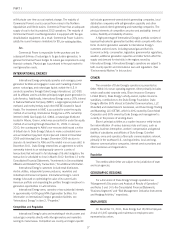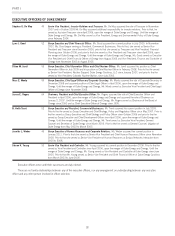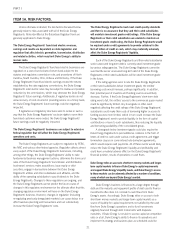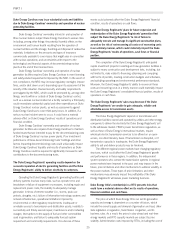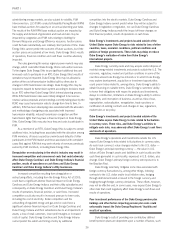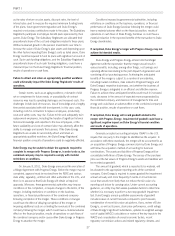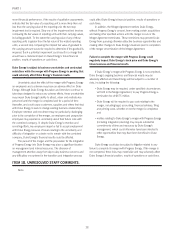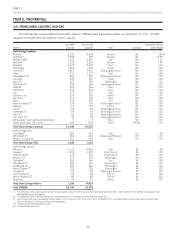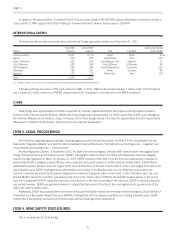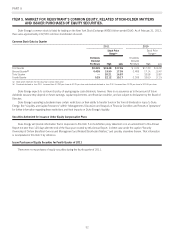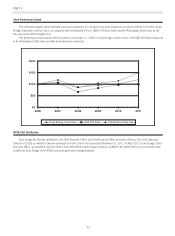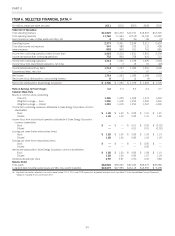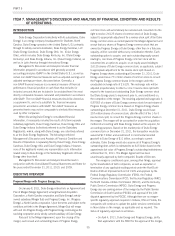Duke Energy 2011 Annual Report Download - page 46
Download and view the complete annual report
Please find page 46 of the 2011 Duke Energy annual report below. You can navigate through the pages in the report by either clicking on the pages listed below, or by using the keyword search tool below to find specific information within the annual report.
PART I
administering energy markets, are also subject to volatility. PJM
Interconnection, LLC (PJM) conducts Reliability Pricing Model (RPM)
base residual auctions for capacity on an annual planning year basis.
TheresultsofthePJMRPMbaseresidualauctionareimpactedby
the supply and demand of generation and load and also may be
impacted by congestion and PJM rules relating to bidding for
Demand Response and Energy Efficiency resources. Auction prices
could fluctuate substantially over relatively short periods of time. Duke
Energy Ohio cannot predict the outcome of future auctions, but if the
auction prices are sustained at low levels, Duke Energy Ohio’s results
of operations, financial condition and cash flows could be adversely
impacted.
The rules governing the various regional power markets may also
change, which could affect Duke Energy Ohio’s costs and/or revenues.
To the degree Duke Energy Ohio incurs significant additional fees and
increased costs to participate in an RTO, Duke Energy Ohio’s results of
operations may be impacted. Duke Energy Ohio may be allocated a
portion of the cost of transmission facilities built by others due to
changes in RTO transmission rate design. Duke Energy Ohio may be
required to expand its transmission system according to decisions made
by an RTO rather than Duke Energy Ohio’s internal planning process.
While PJM transmission rates were initially designed to be revenue
neutral, various proposals and proceedings currently taking place by the
FERC may cause transmission rates to change from time to time. In
addition, PJM has been developing rules associated with the allocation
and methodology of assigning costs associated with improved
transmission reliability, reduced transmission congestion and firm
transmission rights that may have a financial impact on Duke Energy
Ohio. Duke Energy Ohio may also incur fees and costs to participate in
PJM.
As a member of an RTO, Duke Energy Ohio is subject to certain
additional risks, including those associated with the allocation among
PJM members, of losses caused by unreimbursed defaults of other
participants in the PJM market and those associated with complaint
cases filed against PJM that may seek refunds of revenues previously
earned by PJM members, including Duke Energy Ohio.
Deregulation or restructuring in the electric industry may result in
increased competition and unrecovered costs that could adversely
affect Duke Energy Carolinas’ and Duke Energy Indiana’s financial
position, results of operations or cash flows and Duke Energy
Carolinas’ and Duke Energy Indiana’s utility businesses.
Increased competition resulting from deregulation or
restructuring efforts, including from the Energy Policy Act of 2005,
could have a significant adverse financial impact on Duke Energy
Carolinas and Duke Energy Indiana and their utility subsidiaries and
consequently on Duke Energy Carolinas’ and Duke Energy Indiana’s
results of operations, financial position, or cash flows. Increased
competition could also result in increased pressure to lower costs,
including the cost of electricity. Retail competition and the
unbundling of regulated energy and gas service could have a
significant adverse financial impact on Duke Energy Carolinas and
Duke Energy Indiana and their subsidiaries due to an impairment of
assets, a loss of retail customers, lower profit margins or increased
costs of capital. Duke Energy Carolinas and Duke Energy Indiana
cannot predict the extent and timing of entry by additional
competitors into the electric markets. Duke Energy Carolinas and
Duke Energy Indiana cannot predict when they will be subject to
changes in legislation or regulation, nor can Duke Energy Carolinas
and Duke Energy Indiana predict the impact of these changes on
their financial position, results of operations or cash flows.
Duke Energy’s investments and projects located outside of the
United States expose Duke Energy to risks related to laws of other
countries, taxes, economic conditions, political conditions and
policies of foreign governments. These risks may delay or reduce
Duke Energy’s realization of value from Duke Energy’s
international projects.
Duke Energy currently owns and may acquire and/or dispose of
material energy-related investments and projects outside the U.S. The
economic, regulatory, market and political conditions in some of the
countries where Duke Energy has interests or in which Duke Energy
may explore development, acquisition or investment opportunities
could present risks related to, among others, Duke Energy’s ability to
obtain financing on suitable terms, Duke Energy’s customers’ ability
to honor their obligations with respect to projects and investments,
delays in construction, limitations on Duke Energy’s ability to enforce
legal rights, and interruption of business, as well as risks of war,
expropriation, nationalization, renegotiation, trade sanctions or
nullification of existing contracts and changes in law, regulations,
market rules or tax policy.
Duke Energy’s investments and projects located outside of the
United States expose Duke Energy to risks related to fluctuations
in currency rates. These risks, and Duke Energy’s activities to
mitigate such risks, may adversely affect Duke Energy’s cash flows
and results of operations.
Duke Energy’s operations and investments outside the U.S.
expose Duke Energy to risks related to fluctuations in currency rates.
As each local currency’s value changes relative to the U.S. dollar —
Duke Energy’s principal reporting currency — the value in U.S.
dollars of Duke Energy’s assets and liabilities in such locality and the
cash flows generated in such locality, expressed in U.S. dollars, also
change. Duke Energy’s primary foreign currency rate exposure is to
the Brazilian Real.
Duke Energy selectively mitigates some risks associated with
foreign currency fluctuations by, among other things, indexing
contracts to the U.S. dollar and/or local inflation rates, hedging
through debt denominated or issued in the foreign currency and
hedging through foreign currency derivatives. These efforts, however,
may not be effective and, in some cases, may expose Duke Energy to
other risks that could negatively affect Duke Energy’s cash flows and
results of operations.
Poor investment performance of the Duke Energy pension plan
holdings and other factors impacting pension plan costs could
unfavorably impact the Duke Energy Registrants’ liquidity and
results of operations.
Duke Energy’s costs of providing non-contributory defined
benefit pension plans are dependent upon a number of factors, such
26



